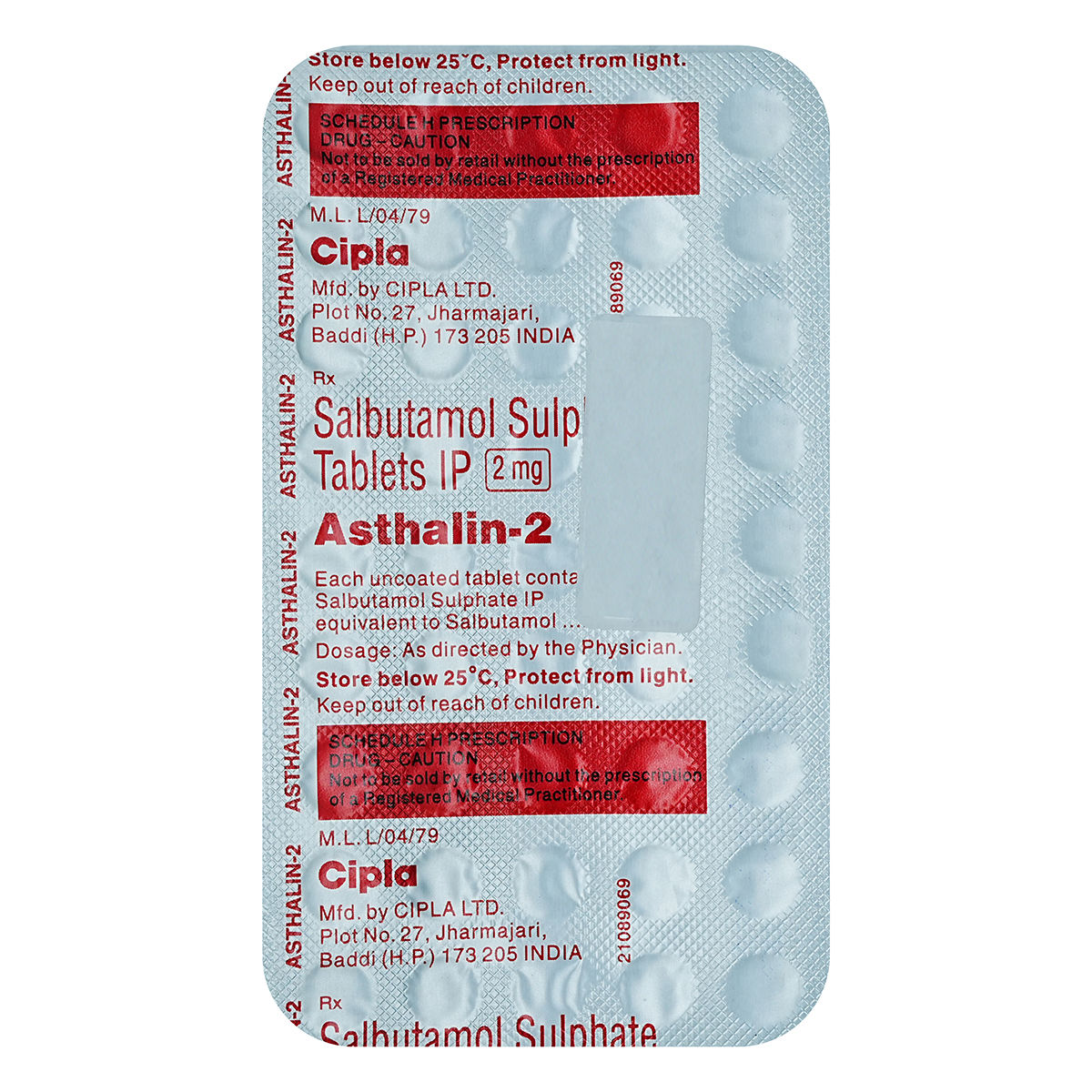Salbutamol
About Salbutamol
Salbutamol is used to treat asthma and chronic obstructive pulmonary disease (COPD). Salbutamol helps relieve symptoms like coughing, wheezing and shortness of breath. Asthma is a breathing problem in which airways narrow, swell and produce extra mucus, leading to difficulty breathing. COPD is a group of lung diseases with emphysema (shortness of breath) and chronic bronchitis (inflammation of the lining of the bronchial tubes).
Salbutamol contains 'Salbutamol,' a bronchodilator. It relaxes the muscles in the airways and increases airflow to the lungs. Salbutamol makes breathing easier by widening the airways. Thus, it provides relief from symptoms such as coughing, wheezing and shortness of breath.
Use Salbutamol as prescribed. Your doctor will advise on how often you need to take Salbutamol based on your medical condition. The common side effects of Salbutamol include nausea, vomiting, restlessness, headache, muscle tightness, dryness or soreness of the throat, dizziness, sleepiness, nasal congestion (stuffy nose), and increased heart rate. Most of these side effects of Salbutamol do not require medical attention and gradually resolve over time. However, if the side effects are persistent, please seek medical help.
Inform your doctor if you have any heart, liver or kidney diseases, hyperthyroidism (overactive thyroid), stomach ulcer, seizure (fits), high blood pressure or diabetes. Salbutamol may cause a rise in blood sugar levels. Hence, diabetic patients should monitor their blood glucose levels and use this medicine only with a doctor's advice. Please check with your doctor if you are pregnant, breastfeeding, or taking any other medicines. Avoid drinking alcohol while taking Salbutamol as it can cause increased sleepiness. Try not to stop taking this medicine on your own.
Uses of Salbutamol
• Bronchodilation: Salbutamol is primarily prescribed to relieve bronchospasms caused by conditions like asthma and chronic obstructive pulmonary disease (COPD), aiding in easier breathing during episodes.
• Rescue Medication: Salbutamol functions as a quick-relief inhaler during asthma attacks, offering fast-acting relaxation of airway muscles.
• Prevention of Exercise-Induced Bronchospasm: Salbutamol can be used before physical activities to prevent shortness of breath or wheezing triggered by exercise.
• Management of Chronic Respiratory Conditions: Salbutamol can be a part of broader treatment plan for chronic respiratory issues, helping to control symptoms and improve lung function over time.
Medicinal Benefits
Salbutamol contains Salbutamol, a bronchodilator. It helps treat respiratory problems like asthma, chronic obstructive pulmonary disease (COPD) and chronic bronchitis. It works by relaxing and widening the lungs' airways, making it easier to breathe, especially in asthma and COPD patients.
Directions for Use
Inhaler: Hold the inhaler with the mouthpiece facing downwards. Form a tight seal by placing your lips around the mouthpiece. Then, press down the inhaler once to release the medication. Breathe in slowly and hold your breath for 5 to 10 seconds. Breathe out slowly. Repeat the process until you have inhaled the number of puffs prescribed by the doctor. Respule/Transpule: Twist off the top of the respule/transpule and squeeze the solution into the nebulizer. This solution is made into a fine mist to breathe in. Inhale the medicine through the nebulizer's mouthpiece. Rotacap: Rotacap is a capsule with powdered medication placed in a Rotahaler. It is for inhalation only. Do not swallow the capsule. Rotahaler is a plastic inhalation device that releases the medication when you breathe. The capsule should be placed at the base of the rotahaler, and the mouthpiece should be completely twisted until you hear a clicking sound. Then, breathe in through the mouthpiece deeply and hold your breath for 10 seconds. Remove the device and breathe out normally. Respirator solution: Do not swallow or inject the solution. Place the prescribed amount of solution in the medicine reservoir or nebulizer cup on the machine. Use the mouthpiece to breathe in the medicine. Use the nebulizer machine for 5 to 15 minutes or until the medicine in the nebulizer is finished.
Storage
Side Effects of Salbutamol
Nausea
Vomiting
Restlessness
Headache
Muscle tightness
Dryness or soreness of the throat
Dizziness
Sleepiness
Nasal congestion (stuffy nose)
Drug Warnings
Inform your doctor beforehand if you have any heart, liver, or kidney diseases, hyperthyroidism (overactive thyroid), stomach ulcer, seizure (fits), high blood pressure or diabetes. Salbutamol may cause hypokalaemia (low potassium levels in the blood) in some patients leading to severe heart diseases, so Salbutamol should be used cautiously. Let your doctor know if you are pregnant or breastfeeding. Limit alcohol intake since it may worsen the side effects like sleepiness and shakiness.
Drug Interactions
Drug-Drug Interaction: Salbutamol may interact with non-selective beta-blocking drugs (propranolol), antidepressants (clomipramine), anti-hypertensive drugs (guanethidine and methyldopa), anti-anxiety drugs (diazepam, lorazepam), blood clot drugs (ticlopidine), gout drugs (allopurinol), heart rhythm drugs (verapamil), hormone problems/birth control drugs (oestrogen, progesterone), immune disorder drugs, anti-seizure drugs (phenobarbital, phenytoin), and stomach acid-reducing drugs (cimetidine).
Drug-Food Interaction: Limit alcohol intake since it may worsen the side effects like sleepiness and shakiness.
Drug-Disease Interaction: If you have gastric or peptic ulcer, sepsis, hypokalaemia (low potassium in the blood), lactic acidosis (excess acid in the bloodstream), liver/kidney diseases (especially cirrhosis or hepatitis), fluid in the lungs, heart problems, overactive thyroid, and seizures (fits), inform your doctor before taking Salbutamol.
Drug-Drug Interactions Checker List:
Safety Advice

Alcohol
unsafeYou are recommended not to consume alcohol along with Salbutamol to avoid unpleasant side-effects like drowsiness, dizziness, or sleepiness.

Pregnancy
cautionPlease consult your doctor if you are planning to become pregnant or already pregnant before starting Salbutamol.

Breast Feeding
cautionThere is limited data on how Salbutamol affects breastfeeding. Please consult your doctor before starting Salbutamol.

Driving
cautionSalbutamol usually causes dizziness, drowsiness, muscle cramps and visual disturbances, which may affect the ability to drive or operate machinery. So, do not drive or operate heavy machinery if you feel sleepy or dizzy after taking Salbutamol.

Liver
cautionSalbutamol should be used with caution in patients with liver diseases. Let your doctor know if you have any history of liver diseases or hepatic impairment. Your doctor will weigh the benefits and potential risks before prescribing Salbutamol.

Kidney
cautionSalbutamol should be used with caution in patients with kidney diseases. Let your doctor know if you have any history of kidney diseases. Your doctor will weigh the benefits and potential risks before prescribing Salbutamol.

Children
cautionSalbutamol is not recommended for children under two years of age. However, it can be given to children above two years of age only if the doctor has prescribed it.
Habit Forming
Diet & Lifestyle Advise
Know your triggers like allergens, such as pollen, dust and food items that make your asthma severe.
Quit smoking and avoid passive smoking. Smoking also reduces the effectiveness of Salbutamol.
Eat a healthy diet and exercise regularly to strengthen your breathing muscles and boost your immune system.
Learning breathing exercises will help you move more air in and out of your lungs.
Special Advise
Monitor your blood glucose levels regularly since bronchodilators can raise blood sugar levels.
Patients Concern
Disease/Condition Glossary
Asthma: It is a condition in which airways narrow, swell and may produce extra mucus, which may lead to breathing difficulty and trigger cough, a whistling sound (wheezing) when you breathe out and shortness of breath.
Chronic obstructive pulmonary disease (COPD): It is a group of progressive lung diseases, most commonly emphysema (shortness of breath) and chronic bronchitis (inflammation and irritation of bronchial tubes). Initially, it may be mild, but in severe cases, it can lead to total blockage of airways and damage to the lungs.
FAQs
Salbutamol is used to treat asthma and chronic obstructive pulmonary disease (COPD). It helps relieve symptoms like coughing, wheezing and shortness of breath.
Salbutamol works by relaxing the muscles in the airways and increasing airflow to the lungs.
Salbutamol should be cautiously used only under a doctor's supervision if you have any heart, liver, kidney diseases, hypokalaemia (low potassium levels), hyperthyroidism (overactive thyroid), stomach ulcer, seizure (fits), high blood pressure, or diabetes.
Salbutamol can cause a rise in blood glucose levels. Hence monitor your blood glucose levels if you have diabetes and inform your doctor so that the dose can be adjusted accordingly.
Bronchodilators may cause central nervous system stimulation. Hence Salbutamol is recommended to be used with caution in patients with seizures as it might worsen your condition. Please consult your doctor if you have any concerns.
Salbutamol can cause hypokalaemia in some patients leading to cardiovascular effects. Please consult your doctor before taking Salbutamol if you are a hypokalaemia patient.










